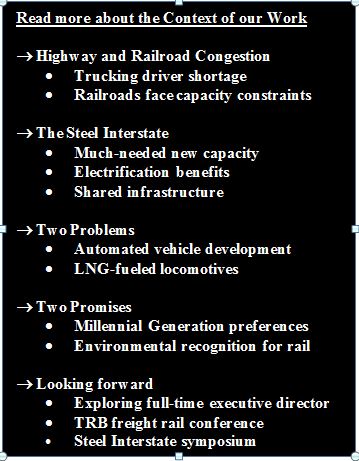Highway and Rail Congestion
Both highways and railroads in the U.S. are chronically congested. Trucking faces severe driver shortages and high fuel costs. Railroad capacity was drastically downsized during the build-out of the Interstate Highway System, and cannot currently absorb extra freight from congested highways. But population and transportation demand are inexorably growing at challenging rates. Railroads can be a critical component of THE solution.
FACT: Double-tracking a single-track rail line can increase capacity seven-fold in only 15 feet of space, often already in place.
FACT: New rail capacityis safer, cleaner, cheaper, can be added more quickly, and has a far less environmental impactthan road-building.
FACT: The Highway Trust Fund is nearly bankrupt, and increasingly, highway spending is needed simply to rehabilitate aging roads and bridges constructed over the past 50 years.
The Steel Interstate Answer
Analogous to what the Eisenhower Interstate Highway System did for road transportation, the Steel Interstate would create a national network of high-capacity, grade-separated, electrified railroad mainlines. This would be the backbone for movement of goods (and people) for decades to come.
The Steel Interstate directly addresses three problems in the rail industry today. First, it would add significant new capacity by rebuilding key rail corridors to Steel Interstate standards. Secondly electrification helps wean the U.S. transportation sector from its near total dependence on oil. Many different means exist to generate electricity, including renewable energy. And third, it holds promise of national passenger service using shared infrastructure. Ubiquitous 79-mph passenger trains can benefit far more people than hugely expensive, high-speed rail that is practical only in a few densely populated corridors.
While the Steel Interstate concept is national in scope, it has overwhelming applicability in Corridors such as I-81/I-40 between the Northeast and the Southwest, where trucking density is among the highest in the nation, or I-80 from California through Salt Lake City and on to the Midwest.
Two Problematic Initiatives:
An intelligent compromise exists for the railroads whereby they benefit from using cheap gas to generate electricity, and then use the electricity to efficiently power trains.
- Hundreds of millions of dollars are being plowed into automated vehicle research – cars and trucks that drive themselves. In some cases these concepts involve technological upgrades to highways to provide guidance systems. Manifest justification lies in claims that 93% of vehicular crashes stem from human error, and computer control can eliminate this.
Completely apart from the profoundly scary prospect of such computers programmed by fallible humans is that such automated cars and trucks would wed the nation to reliance on highway transportation for the indefinite future.
- Smitten by current low prices for natural gas, the railroad industry is experimenting with locomotives fueled by liquefied natural gas (LNG). LNG-powered trains like electrified ones would require vast new infrastructure investment. However railroad electrification is commonplace around the world so the technology is safe, proven and available. Safety is a major concern with creation, storage, and use of a high-pressure cryogenic liquid fuel. Some critics have claimed that it would take as much electricity just to compress and cool the LNG as it would to power the trains directly. If railroads opt to go with LNG, they will have bet their future on a single fuel, whereas electrification gives access to a wide choice of fossil fuels, nuclear, and renewable sources, as well as efficiencies, such as regenerative braking.
An intelligent compromise exists for the railroads whereby they benefit from using cheap gas to generate electricity, and then use the electricity to efficiently power trains.
Learn more about:

